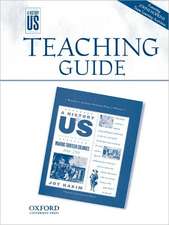Making Numbers: Using manipulatives to teach arithmetic
Autor Rose Griffiths, Sue Gifford, Jenni Backen Limba Engleză Paperback – 29 sep 2016
Preț: 271.88 lei
Preț vechi: 317.25 lei
-14% Nou
Puncte Express: 408
Preț estimativ în valută:
52.03€ • 54.18$ • 43.97£
52.03€ • 54.18$ • 43.97£
Carte disponibilă
Livrare economică 07-13 februarie
Livrare express 01-07 februarie pentru 73.22 lei
Preluare comenzi: 021 569.72.76
Specificații
ISBN-13: 9780198375616
ISBN-10: 0198375611
Pagini: 112
Ilustrații: Colour
Dimensiuni: 190 x 246 x 7 mm
Greutate: 0.33 kg
Editura: OUP OXFORD
Colecția OUP Oxford
Locul publicării:Oxford
ISBN-10: 0198375611
Pagini: 112
Ilustrații: Colour
Dimensiuni: 190 x 246 x 7 mm
Greutate: 0.33 kg
Editura: OUP OXFORD
Colecția OUP Oxford
Locul publicării:Oxford
Recenzii
This is a visually striking book full of high quality colour photographs of manipulatives for learning maths. The generosity of images makes it extremely accessible. The book presents many practical activities for developing children's understanding of number relationships. These activities are soundly based on up to date research into how children develop number sense. This makes it a must buy - a really supportive, evidence-based resource for all those who teach foundation stage and key stage one classes.
This is an excellent book, full of practical ideas to help develop children's understanding of number. The images used show how you can use everyday resources to help develop children's understanding of number without needing to spend lots of money on new resources, and the small snippets of research help you to understand why the activities suggested can help children to understand number. It is written in an easy to read style and can be dipped into and out of, a great tool to help support planning for maths in the EYFS. It even covers trickier concepts such as introducing addition and subtraction, and gives you advice on how to make this meaningful for children to understand.
This book should be in every primary school. Correction, in every KS1 and early KS2 classroom. It is full of practical and well-researched guidance on the teaching of number using a wide range of manipulatives and open-ended tasks which prioritise sense-making through discussion. The authors have a solid background in early years mathematics education and explain clearly the research backing up the tasks and the variety of images supported by the different manipulatives. The book is full of colour images making progression clear and gradually builds over successive chapters from working with smaller numbers to the development of images for the division of numbers between 25 and 100. It would be an invaluable resource for Teaching Assistants, SEND teachers and all teachers who want to understand clearly the lines of progression in children's understanding of number and calculation.
Just rereading sections of this fabulous book from the terrific trio that is Rose Griffiths, Jenni Back, and Sue Gifford. Some books you come back to time and time again.
This is an excellent book, full of practical ideas to help develop children's understanding of number. The images used show how you can use everyday resources to help develop children's understanding of number without needing to spend lots of money on new resources, and the small snippets of research help you to understand why the activities suggested can help children to understand number. It is written in an easy to read style and can be dipped into and out of, a great tool to help support planning for maths in the EYFS. It even covers trickier concepts such as introducing addition and subtraction, and gives you advice on how to make this meaningful for children to understand.
This book should be in every primary school. Correction, in every KS1 and early KS2 classroom. It is full of practical and well-researched guidance on the teaching of number using a wide range of manipulatives and open-ended tasks which prioritise sense-making through discussion. The authors have a solid background in early years mathematics education and explain clearly the research backing up the tasks and the variety of images supported by the different manipulatives. The book is full of colour images making progression clear and gradually builds over successive chapters from working with smaller numbers to the development of images for the division of numbers between 25 and 100. It would be an invaluable resource for Teaching Assistants, SEND teachers and all teachers who want to understand clearly the lines of progression in children's understanding of number and calculation.
Just rereading sections of this fabulous book from the terrific trio that is Rose Griffiths, Jenni Back, and Sue Gifford. Some books you come back to time and time again.






